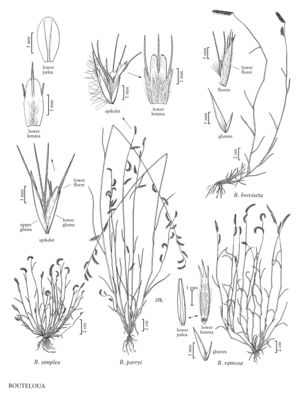Bouteloua breviseta
Plants perennial; sometimes cespitose, sometimes rhizomatous, rhizomes 1-3 mm thick, short or elongate, scaly. Culms 20-40 cm, erect, somewhat woody at the base, branching at the base and, in late fall, sometimes at the aerial nodes; nodes usually 4-5; internodes glabrous, distal portions of the lower internodes with a thick, white, chalky bloom. Ligules 0.1-0.2 mm, of hairs; blades 1-4(7) cm long, 0.5-2 mm wide, flat basally, involute and arcuate to reflexed distally. Panicles 2-A cm, with 1-3(4) branches; branches 15-37 mm, persistent, straight to slightly arcuate, mostly appressed, stramineous, with 30-45 spikelets, branches terminating in a reduced, needlelike, 2-5 mm spikelet; disarticulation above the glumes. Spikelets pectinate, with 1 bisexual floret and 1-2 rudimentary florets. Glumes acute to acuminate, glabrous or sparsely short-hairy, hairs not papillose-based; lower glumes 2-2.5 mm; upper glumes 2-3.5 mm; lowest lemmas 2.5-4 mm, sparsely to densely hairy, 3-awned, awns slightly shorter than the lemma bodies, central awns flanked by 2 membranous lobes; lowest paleas about 4.5 mm, mostly or completely glabrous, sometimes puberulent distally, acute to acuminate, unawned, veins not excurrent; second florets about 4.5 mm, 3-awned, awns 3-5 mm; rachilla segments subtending second florets with densely pubescent apices; third florets, if present, flabellate scales, 1-awned. Caryopses 1-1.2 mm long, about 0.4 mm wide. 2n = 20.
Distribution
N.Mex., Tex.
Discussion
Bouteloua breviseta is locally abundant on gypsum soils in southeastern New Mexico and the northern portion of the Trans Pecos region in Texas. It also grows in the state of Chihuahua, Mexico. Reeder and Reeder (1980) provide an excellent discussion of B. breviseta and B. ramosa.
Selected References
None.
